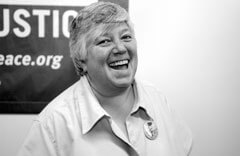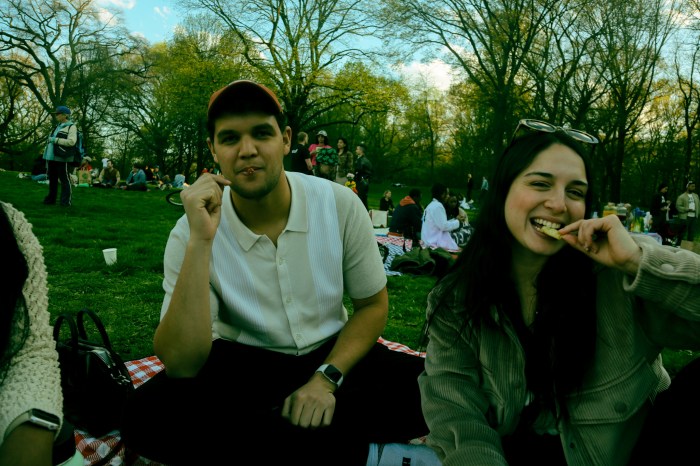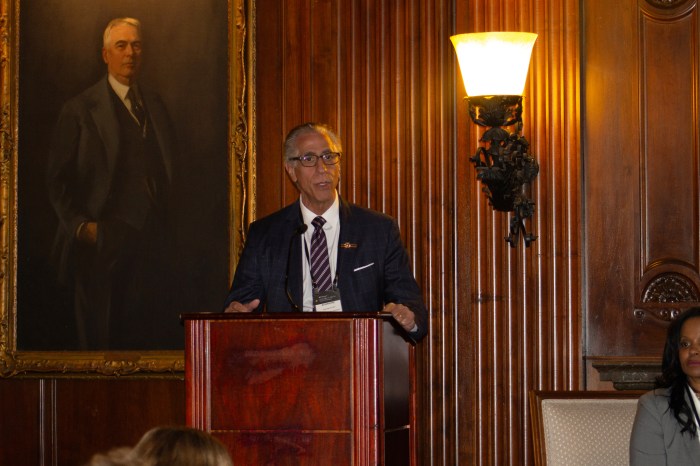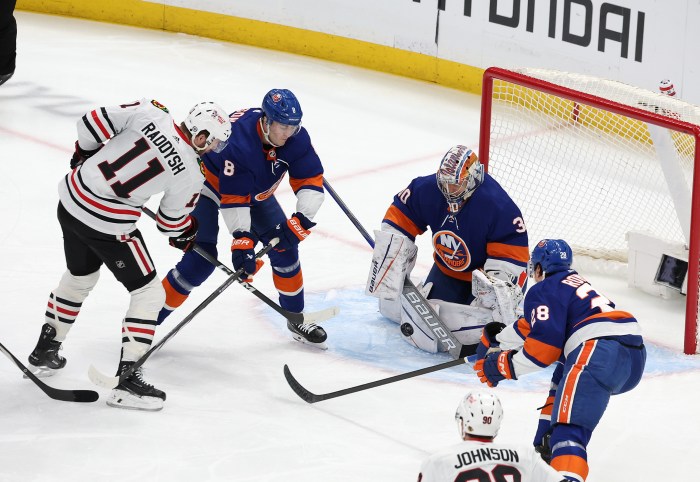United For Peace and Justice Scrambles To Finalize Plans for Sunday’s Protest
Just four days before what is expected to be the largest protest march during the Republican National Convention, the anti-war group United For Peace and Justice (UFPJ) was turned back in its effort to challenge the legality of the city’s refusal to issue a permit for use of Central Park.
The ruling, issued Wednesday afternoon, leaves unsettled the question of where hundreds of thousands of protesters who gather for an event dubbed “The World Says No to the Bush Agenda” will go after they march past the convention site, Madison Square Garden, early on Sunday afternoon, August 29, the eve of the G.O.P. meeting. Protesters will gather from Fifth Avenue to Ninth Avenue between 15th and 22nd Streets beginning at 10 a.m. and head uptown beginning at noon.
The ruling by Justice Jacqueline W. Silbermann of the New York State Supreme Civil Court found that New York City acted legally in denying UFPJ’s application for use of three sites in the Park, including the Great Lawn, for its post-march rally on Sunday, August 29.
In its application to use the park, UFPJ had estimated that as many as a quarter million people could turn out for Sunday’s event. However, given the size of two previous marches sponsored by UFPJ, both in the weeks leading up to the start of the war in Iraq in the late winter of 2003, the size of Sunday’s turnout could easily top that estimate.
Just two days prior to Silbermann’s ruling, William H. Pauley III, a Manhattan federal court judge, denied challenges from two other groups—the National Council of Arab Americans and the Act Now to Stop War & End Racism Coalition—to use the Great Lawn on Saturday, August 28 for protests.
In both cases, the city argued that the size of the crowds would damage the Great Lawn and the North Meadow, which it said have undergone $27 million in renovations in recent years.
As Gay City News went to press late Wednesday evening, UFPJ officials were huddled with officials from the New York Police Department, as they had been all day—even before the ruling came down—to search for some way to accommodate the requirements of both sides and ensure safety of all participants in the protest.
“We are not going to lead this march to do anything illegal. This march is going to be fully legal [and] as safe as possible,” UFPJ spokesperson Bob Wing told the newspaper as his group’s negotiations with police continued.
Wing said that a resolution could come as early as Wednesday night, but added that UFPJ planned a 1 p.m. press conference Thursday to announce its plans for Sunday. The Rev. Jesse Jackson, currently in Libya, is expected to join the press conference via video hook-up, as are local officials who have backed the group’s protest plans. Harlem City Councilmember Bill Perkins, a Democrat, has been among the most visible elected officials supporting UFPJ.
“Based on the discussions [with police], we are hopeful that we will get a route that is mutually acceptable,” Wing said.
In comments several hours later, Bill Dobbs, another UFPJ spokesperson with a long record of activism on gay, AIDS, and civil liberties issues, said conversations with the NYPD were continuing and that staging a formal rally was no longer on the table. He said UFPJ’s main concern was to establish a route beyond Madison Square Garden where protesters could safely disperse.
Dobbs would not rule out the possibility that if negotiations with the police break down, UFPJ might not appeal Silbermann’s ruling.
“If we win, that would be great, but there is going to be a large number of people joining us in the march,” Dobbs had said in advance of the Silbermann ruling. “We have to make sure that people have enough room to stretch out and can disperse in an easy fashion.”
During a three-hour hearing before Silbermann on August 24, Leslie Cagan, UFPJ’s national coordinator, squared off in testimony against Elisabeth Smith, the chief of marketing and corporate sponsorship for the city’s Parks Department.
Cagan, who led UFPJ’s anti-war organizing last year, is a long time lesbian activist who was instrumental in planning several of the early queer marches on Washington beginning in 1979.
Silbermann also heard arguments from lawyers for both sides. Attorney Jeffrey Fogel, who represented UFPJ and is the legal director for the Center for Constitutional Rights, said the group would agree to forgo use of the Great Lawn in the event of rain, and would post bond, in a yet undetermined amount, as insurance against damage. He also said the group has volunteers who have pledged to assist in the park’s cleanup.
The city’s attorney, Jonathan Pines, cited the Parks Department’s Active Management Plan, a document unknown to UFPJ, which lays out restrictions on activities allowed in different park properties. Pines also argued that UFPJ’s request for use of the park—the group re-applied for a permit on August 10 and filed its lawsuit on August 18—left too little time in advance of the August 29 event.
The battle over using Central Park has been a long-running one. Earlier this year, the city consistently denied UFPJ’s request to use the park, specifically rejecting an earlier application. On July 21, perhaps fearful that it was running out of time, UFPJ accepted in principle the city’s offer to use West Street above Chambers Street for a rally, though the group laid down certain conditions related to access, safety and the availability of cold water. Subsequent to that agreement, however, UFPJ faced criticism from many in its coalition for buckling to city intransigence about Central Park and said the city never responded to the conditions it had raised.
By August 10, the group was once again focused on Central Park for its rally site.
During the August 24 hearing, Cagan outlined a contingency proposal that would have limited the number of protesters admitted to Central Park to 75,000.
´We would have a very limited incursion into Central Park that I think is very easily handled by Parks and the police,” Fogel said of that proposal, in a press conference following the Tuesday hearing. “If we did that, we would have won the victory for speech in the park and we will have avoided many of the problems they have raised.”
Cagan explained that the remainder of the crowd would have been funneled onto Central Park West under that contingency proposal.
In the hours before Silbermann’s ruling, Dobbs sought to cast the battle over the Central Park permit in a larger context.
“This dispute over the park has blossomed into one of the largest civil liberties issue in the country that I know of,” he said. “This is critical to the basic right to dissent. What is the importance of the park? Almost every square foot of Manhattan has a building on it and the open space is very precious, but not just for recreation. It is the crown jewel of the city’s park system, and one of the most famous, if not the most famous park in the world. It is also our town common. Central Park is the only open space where large groups of people can gather to protest and it has been the site of many high profile demonstrations over the years.”
Gary Ferdman, executive director of the organization Business Leaders for Sensible Priorities, which promotes humane government practices, also spoke about the importance of Central Park at the Tuesday press conference following the hearing.
“I’m 100 percent on the side of United for Peace and Justice,” Ferdman said. “I do think the mayor is being disingenuous on the one hand saying, ‘Welcome, come and enjoy everything the city has to offer,’ and on the other hand offering the West Side Highway—it is literally the garage of New York City.”
Richard Tur, holding a handwritten sign stating “It’s 2004, not 1984” as he stood near the Tuesday press conference, indicated that he might end up in Central Park if that is the final stop of his fellow demonstrators.
“Technically, there’s nothing to stop someone from going to the Great Lawn at Central Park and having a day out, so if you just happen to be there for a cause,” said Tur. “I think that this whole business about the mayor not letting the protestors go because it will ruin the grass doesn’t hold water with me. Grassroots is more important than lawn green.”
For the latest information on plans for Sunday’s protest, visit unitedforpeace.org.
Lincoln Anderson and Paul Schindler contributed additional reporting on this story.


































